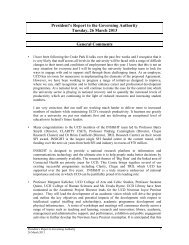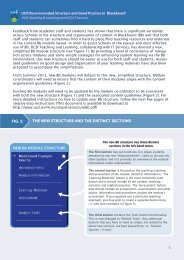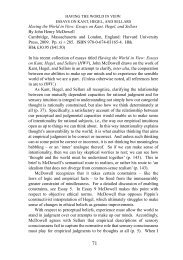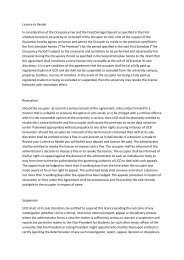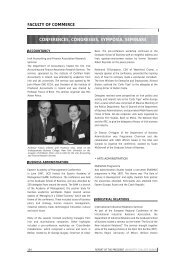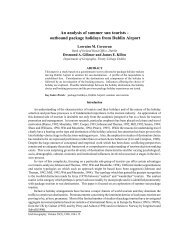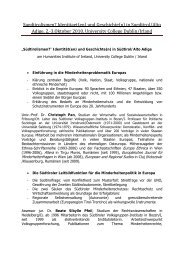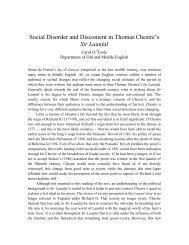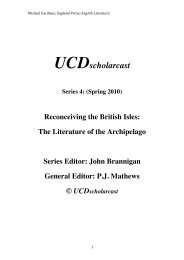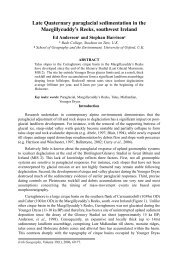UCD Woodland Walks Map and Guide - University College Dublin
UCD Woodland Walks Map and Guide - University College Dublin
UCD Woodland Walks Map and Guide - University College Dublin
Create successful ePaper yourself
Turn your PDF publications into a flip-book with our unique Google optimized e-Paper software.
<strong>UCD</strong> <strong>Woodl<strong>and</strong></strong> <strong>Walks</strong><br />
<strong>Map</strong> <strong>and</strong> <strong>Guide</strong><br />
<strong>UCD</strong> <strong>Woodl<strong>and</strong></strong> <strong>Walks</strong><br />
Since the 1930s, when <strong>University</strong> <strong>College</strong> <strong>Dublin</strong>’s Belfield<br />
campus was formed through the purchase of some of <strong>Dublin</strong>’s<br />
finest period houses <strong>and</strong> estates, the campus has provided<br />
an important amenity to students, staff <strong>and</strong> the local<br />
community. Today <strong>UCD</strong> is known for its parkl<strong>and</strong> setting <strong>and</strong><br />
mature l<strong>and</strong>scaping. Now over 8km of woodl<strong>and</strong> paths have<br />
been created <strong>and</strong> a series of walks developed to open up the<br />
beautiful 133 hectare campus to a wider community.<br />
Each walk has its own unique characteristics. Along<br />
the me<strong>and</strong>ering paths, walkers will pass many mature<br />
trees dating from the 18 th <strong>and</strong> early 19 th centuries, which<br />
complement areas of new woodl<strong>and</strong> planted as part of <strong>UCD</strong>’s<br />
programme to maintain <strong>and</strong> enhance the ecological diversity<br />
of the campus for the benefit of all.<br />
Purple Loosestrife photographed<br />
near Woodview wetl<strong>and</strong>s<br />
Part of the Oak Walk developed as a<br />
Millennium project
Horse Chestnut in spring<br />
<strong>UCD</strong> Campus <strong>Woodl<strong>and</strong></strong> Facts<br />
• 25,000 trees in 1996<br />
• 50,000+ trees in 2011<br />
• 75 different species<br />
• 15,000+ mature/semi-mature trees<br />
• 9ha of campus woodl<strong>and</strong> coverage<br />
• 8km of woodl<strong>and</strong> paths<br />
Planting for the Future<br />
New areas of woodl<strong>and</strong> have been planted on campus each<br />
year since 1998. Where appropriate, the species of trees<br />
planted in each location reflect those originally planted at<br />
the time when the l<strong>and</strong> was in private estates. Approximately<br />
25,000 trees have been planted increasing the overall<br />
woodl<strong>and</strong> coverage on campus from 5.6 hectares to almost<br />
9 hectares. The intention is to continue to exp<strong>and</strong> campus<br />
woodl<strong>and</strong> over the coming years with these trees living for the<br />
next 100 to 200 years.<br />
On your Walk<br />
• Keep to the path in wooded areas<br />
• You can get a cup of coffee in many locations on campus<br />
• Take time to visit new <strong>and</strong> interesting parts of the campus<br />
<strong>and</strong> watch out for artwork <strong>and</strong> sculptures along the way<br />
• Learn more about the Programme for Preservation of<br />
Period Houses at <strong>UCD</strong> (www.ucd.ie/campusdevelopment)<br />
• In an emergency call <strong>UCD</strong> First Response Room on<br />
01 7167999<br />
• Keep your dog on a leash at all times <strong>and</strong> clean up after it<br />
Notable Trees on Campus<br />
There are many notable trees on campus known for their beauty,<br />
in particular in Belfield Wood (located adjacent to Belfield House),<br />
Foster’s Avenue Wood (located between Merville House <strong>and</strong> along<br />
Foster’s Avenue), <strong>and</strong> the Oak Walk (which runs from the rear of<br />
the <strong>UCD</strong> Veterinary Sciences Centre to the rear of the <strong>UCD</strong> Conway<br />
Institute). A number of these trees have been highlighted on the<br />
map.<br />
In addition to these trees, many other rare <strong>and</strong> exotic trees are<br />
located in areas close to the gardens <strong>and</strong> grounds of the former<br />
estate houses such as Belfield House, <strong>and</strong> along the Rosemount<br />
Walk between the <strong>UCD</strong> Oakmount Crèche <strong>and</strong> the Arboretum.<br />
Contributors<br />
Dr Mary Forrest, <strong>UCD</strong> School of Agriculture, Food Science &<br />
Veterinary Medicine; Damian Egan, <strong>UCD</strong> School of Biology <strong>and</strong><br />
Environmental Science; Billy Clarke, <strong>UCD</strong> School of Biology <strong>and</strong><br />
Environmental Science; Ciaran Beattie, <strong>UCD</strong> Buildings <strong>and</strong> Services;<br />
Eanna Kealey, <strong>UCD</strong> Buildings <strong>and</strong> Services; <strong>and</strong> <strong>UCD</strong> Media Services.<br />
Produced by <strong>UCD</strong> <strong>University</strong> Relations, © Copyright April 2011.<br />
For more visit:<br />
www.ucd.ie/campusdevelopment/woodl<strong>and</strong>walks<br />
7225 Designed <strong>and</strong> produced by www.akgraphics.ie
Trees <strong>and</strong> <strong>Woodl<strong>and</strong></strong><br />
Five walks to<br />
choose from<br />
Millennium Walk – 3.2km,<br />
duration 35-40 minutes<br />
Following a me<strong>and</strong>ering double line<br />
of oak trees, this path stretches<br />
from the <strong>UCD</strong> Bowl to the back<br />
of the <strong>UCD</strong> Veterinary Sciences<br />
Centre, <strong>and</strong> incorporates the <strong>UCD</strong><br />
Newstead Precinct <strong>and</strong> the lakes<br />
<strong>and</strong> wild meadow at Woodview.<br />
The walk includes many features<br />
of ecological importance such as a<br />
pond <strong>and</strong> filter beds, a pine copse<br />
<strong>and</strong> wildflower meadow. This area<br />
has become a valuable habitat for<br />
wildlife <strong>and</strong> has a broad range of<br />
biodiversity. A Golden Ash Walk,<br />
Plane Walk <strong>and</strong> Cherry Grove are<br />
visited along this path.<br />
The campus is formed from a series of suburban estates <strong>and</strong><br />
retains many trees <strong>and</strong> woodl<strong>and</strong>s from the 18 th <strong>and</strong> early 19 th<br />
century. Estate woodl<strong>and</strong> is most noticeable on Foster’s Avenue,<br />
by the Glenomena residences, around the <strong>UCD</strong> Crèche <strong>and</strong> along<br />
the Stillorgan Road. Remnants of residential ornamental tree<br />
planting can be seen at Merville House, Belfield House, Roebuck<br />
Castle <strong>and</strong> Richview.<br />
In the late 18 th century, ornamental conifers were in fashion<br />
<strong>and</strong> a representative collection, including Western Red Cedar,<br />
Giant Redwood, Sawara Cypress <strong>and</strong> Monterey Cypress remain<br />
by Ardmore House. Tall mature Lime trees, originally part of an<br />
estate boundary, line the road from the N11 entrance to the<br />
Daedalus Building. More fine Lime trees st<strong>and</strong> in front of the <strong>UCD</strong><br />
Quinn School <strong>and</strong> recently-planted trees run along the side of the<br />
building.<br />
Tree-planting accompanied the development of the university<br />
in the 1960s <strong>and</strong> 1970s <strong>and</strong> placed more emphasis on the<br />
year-round use of the campus. Pink-flowering Cherries, yellowflowering<br />
Laburnum <strong>and</strong> white-flowering Horse Chestnuts are<br />
conspicuous in April <strong>and</strong> May. Purple-leaved trees such as Norway<br />
<strong>Map</strong>le, Copper Beech <strong>and</strong> Purple Plum are striking in summer <strong>and</strong><br />
can be seen by O’Reilly Hall <strong>and</strong> the path to the N11 entrance.<br />
Rosemount Walk – 1.8km, duration 20-25 minutes<br />
The walk begins <strong>and</strong> ends at the <strong>UCD</strong> Sports Centre. It links<br />
the <strong>UCD</strong> Water Tower, Rosemount (<strong>UCD</strong> Environmental<br />
Research Station), <strong>UCD</strong> Oakmount Crèche, the Arboretum, <strong>and</strong><br />
the O’Kane Centre for Film Studies situated at the Magnetic<br />
Observatory. The Arboretum is a living museum containing<br />
many rare <strong>and</strong> unusual trees dating back to the original<br />
Rosemount estate. The university continues to add specimen<br />
trees <strong>and</strong> has developed a woodl<strong>and</strong> meadow in this area. A<br />
Birch Walk runs down the side of the Magnetic Observatory.<br />
Belfield Walk – 2.4km, duration 30-35 minutes<br />
Encompassing the academic core of the campus, the walk<br />
begins <strong>and</strong> ends at the entrance to the <strong>UCD</strong> James Joyce Library<br />
<strong>and</strong> forms a green link between the heart of the campus <strong>and</strong><br />
the woodl<strong>and</strong> periphery of the former estates. This walk passes<br />
O’Reilly Hall <strong>and</strong> the lake which is home to a number of wildlife<br />
species including swans, ducks, fish <strong>and</strong> a range of other aquatic<br />
based wildlife. The Elm Walk <strong>and</strong> Walnut Grove also feature<br />
along the path.<br />
Long-tailed Tit photographed on campus<br />
Grey-foliaged Weeping Pears, with dome-shaped appearance, are<br />
evident by O’Reilly Hall <strong>and</strong> feature in many conferring photographs.<br />
Weeping Willow, Beech <strong>and</strong> Japanese <strong>Map</strong>les by the Lake offer<br />
striking colours of gold <strong>and</strong> orange in autumn. In winter, whitestemmed<br />
Birch <strong>and</strong> Paper Bark <strong>Map</strong>le are particularly noticeable by<br />
Merville House.<br />
The large area of London Plane trees planted in front of the<br />
Restaurant <strong>and</strong> the Oak Walk, which formed a Millennium project,<br />
are relatively young <strong>and</strong> will grace the campus for many generations<br />
to come.<br />
In recent years, large parts of the boundary woodl<strong>and</strong> have been<br />
augmented with native woodl<strong>and</strong> trees such as Birch, Alder, Oak <strong>and</strong>
Glenomena Walk – 1.9km, duration 20-25 minutes<br />
This walk joins 3.6 hectares of established woodl<strong>and</strong> on campus<br />
including Belfield Wood which runs alongside Belfield House,<br />
Merville Wood which is located alongside Merville House<br />
(Nova<strong>UCD</strong>) <strong>and</strong> Foster’s Avenue Wood. The path includes the<br />
tree lined avenue to Merville House (a Georgian style, two<br />
storey ‘country villa’) <strong>and</strong> the Lime Walk.<br />
Boundary <strong>Woodl<strong>and</strong></strong> Walk – 6.2km, duration 60-70 Minutes<br />
Bringing the walks together, the 6.2km Boundary <strong>Woodl<strong>and</strong></strong><br />
Walk extends around the perimeter of the campus to form a<br />
path linking the original <strong>and</strong> recently-developed woodl<strong>and</strong><br />
areas with the wider campus l<strong>and</strong>scape. Starting at the N11<br />
entrance, the walk reveals some of the hidden treasures of<br />
the campus, such as the wildflower meadow <strong>and</strong> lakes at<br />
Woodview, the Arboretum, <strong>UCD</strong>’s growing collection of<br />
sculpture, a diverse array of wildlife <strong>and</strong> many of the original<br />
period houses.<br />
Willow. Similar planting is also seen between the Glenomena <strong>and</strong><br />
Merville residences <strong>and</strong> by the <strong>UCD</strong> Crèche.<br />
Whether it be the woodl<strong>and</strong> by Foster’s Avenue, the venerable<br />
Horse Chestnut with its large branches leaning ground-wards near<br />
Woodview House or the lone Pine tree by the Daedulus Building,<br />
trees are an integral part of <strong>UCD</strong>’s Belfield Campus.<br />
Birds <strong>and</strong> Insects<br />
The woodl<strong>and</strong>s, wetl<strong>and</strong>s, wildflower meadows <strong>and</strong> mown<br />
grass areas around the campus provide a variety of habitats for<br />
birds, mammals, insects <strong>and</strong> other wildlife. Most of the common<br />
woodl<strong>and</strong> birds breed on campus.<br />
The woodl<strong>and</strong> walks provide views of some birds that are difficult<br />
to see in gardens, such as Sparrowhawk, Stock Dove, Long-tailed<br />
Tit, Goldcrest, Willow Warbler, Chiffchaff, Treecreeper <strong>and</strong><br />
Bullfinch, with Waxwing, Siskin, <strong>and</strong> Brambling as possible winter<br />
visitors. Holly Blue, Orangetip, Speckled Wood, Tortoiseshell<br />
<strong>and</strong> Peacock butterflies avail of the variety of plants found in the<br />
woodl<strong>and</strong>s <strong>and</strong> wildflower meadows of the campus, as do many<br />
wild bees. Some of these insects have quite specific food plant<br />
requirements. The wildflower meadows also provide food for<br />
Woodpigeons <strong>and</strong> Finches, such as Goldfinches, Greenfinches <strong>and</strong><br />
Linnets.<br />
Green Veined White Butterfly captured feeding on campus<br />
A great variety of wildlife is present on the various lakes <strong>and</strong><br />
areas of wetl<strong>and</strong>s on campus. Common waterfowl such as<br />
Mute Swan, Mallard <strong>and</strong> Tufted Duck <strong>and</strong> also Moorhen, Blackheaded<br />
Gull <strong>and</strong> Pied Wagtail can be seen on open water. Birds<br />
such as Grey Heron, Teal, Kingfisher <strong>and</strong> Water Rail may be<br />
present, especially in winter. The Common Chaser Dragonfly<br />
is also evident <strong>and</strong> occasionally the large <strong>and</strong> impressive<br />
Moorl<strong>and</strong> Hawker Dragonfly breeds on campus.<br />
In winter, the playing pitches can attract coastal wading birds,<br />
such as Curlew <strong>and</strong> Oystercatcher to feed. Fieldfares <strong>and</strong><br />
Redwings can also be seen. In spring these birds are replaced by<br />
breeding Blackbirds, Song Thrushs <strong>and</strong> Mistle Thrushs, collecting<br />
worms to feed their chicks.<br />
Sparrowhawk photographed on campus
Roebuck Road<br />
Roebuck Castle<br />
Gate<br />
Roebuck Road<br />
Entrance<br />
Roebuck<br />
Castle<br />
Clonskeagh<br />
Entrance<br />
Owenstown<br />
Entrance<br />
<strong>UCD</strong><br />
Creché<br />
11<br />
Boundary<br />
<strong>Woodl<strong>and</strong></strong> Walk<br />
Clonskeagh Road<br />
14<br />
12<br />
13<br />
Magnetic<br />
Observatory<br />
Richview<br />
Entrance<br />
Water<br />
Tower<br />
Rosemount<br />
Walk<br />
Birch Walk Arboretum<br />
Elm Walk<br />
10<br />
Richview<br />
15<br />
Foster’s Avenue<br />
<strong>UCD</strong><br />
Quinn<br />
School<br />
Merville<br />
Residence<br />
Plane Walk<br />
Sports<br />
Centre<br />
James Joyce<br />
Library<br />
Newman<br />
Building<br />
6<br />
Foster’s Avenue<br />
Entrance<br />
Belfield Walk<br />
9<br />
Lime Walk<br />
Daedalus<br />
Building<br />
Millennium<br />
Walk<br />
<strong>UCD</strong> Science<br />
Centre<br />
Glenomena<br />
Residence<br />
<strong>UCD</strong> Bowl<br />
Ardmore<br />
House<br />
Glenomena<br />
Walk<br />
Walnut Grove<br />
Golden Ash Walk<br />
4 5<br />
O’Reilly<br />
Hall<br />
Nova <strong>UCD</strong><br />
(Merville House)<br />
8<br />
Woodview<br />
Belfield<br />
House<br />
16<br />
Greenfield<br />
Entrance<br />
<strong>UCD</strong> Veterinary<br />
Sciences Centre<br />
1<br />
2<br />
3<br />
7<br />
Oak Walk<br />
17<br />
18<br />
N11<br />
Entrance<br />
< Stillorgan<br />
19<br />
20<br />
N11<br />
Millennium Walk 3.2km duration 35-40 minutes<br />
Rosemount Walk 1.8km duration 20-25 minutes<br />
Donnybrook ><br />
Belfield Walk 2.4km duration 30-35 minutes<br />
Glenomena Walk 1.9km duration 20-25 minutes<br />
Boundary <strong>Woodl<strong>and</strong></strong> Walk 6.2km duration 60-70 Minutes<br />
Notable tree cover Suggested starting points
Notable <strong>UCD</strong> Trees<br />
Key Common Name Scientific Name Brief Description<br />
1 Nootka Cypress Chamaecyparis nootkatensis A particularly fine specimen tree. Notice the graceful pendulous branches<br />
that sweep upwards at the end.<br />
2 Giant Sequoia, Wellingtonia Sequoiadendron giganteum The Giant Sequoia is known to be the world’s largest trees with some<br />
specimens living for hundreds of years. <strong>UCD</strong>’s specimen is still relatively<br />
young.<br />
3 Turkey Oak Quercus cerris A large Oak that is known for its attractive leaf <strong>and</strong> large acorns.<br />
4 Loblolly Pine Pinus taeda The Loblolly Pine is the state tree of Arkansas <strong>and</strong> this specimen was<br />
planted by President Bill Clinton when he visited the <strong>UCD</strong> Clinton<br />
Institute for American Studies on 30th September 2010.<br />
5 Ile x altaclerensis ‘Hodginsii’ Ile x altaclarensis ‘Hodginsii’ A form of Holly raised by the Hodgins Nursery, Dunganstown, Co.<br />
Wicklow in the late 18th Century.<br />
6 Scots Pine Pinus sylvestris Located in Belfield Wood, this is the finest of a small number of mature<br />
Scots Pine on campus. As you approach, take time to look to the top <strong>and</strong><br />
see its wonderful orange bark.<br />
7 Field <strong>Map</strong>le Acer campestre A species known for its unusually small leaf. This group of trees form<br />
particularly big specimens.<br />
8 Foxglove Tree Paulowina tomentosa Also called Empress or Princess Trees, these unusual trees to the rear of<br />
Merville House are known for their attractive mauve flowers.<br />
9 Oriental Plane Platanus orientalis A large deciduous tree famous for its longevity <strong>and</strong> spreading crown.<br />
This tree is estimated to be over 200 years old <strong>and</strong> is one of <strong>UCD</strong>’s most<br />
spectacular specimens.<br />
10 Common Lime Tilia x europaea Estimated to be in the region of 200 years old, this is wonderful specimen<br />
Lime tree.<br />
11 Holm Oak Quercus ilex Also known as Holly Oak, this Oak is one of many wonderful specimen<br />
rare <strong>and</strong> exotic trees located in the Arboretum. A native of the<br />
Mediterranean region.<br />
12 Deodar Cedar Cedrus deodara A majestic specimen, in great condition.<br />
13 Weeping Monteray Cypress Cupressus macrocarpa ‘Pendula’ Known locally as the ‘Weeping Mac’, this rare tree is one of the only few<br />
of its kind known in Irel<strong>and</strong>.<br />
14 Variegated Oak Quercus robur ‘Variegata’ Estimated to be between 150 – 200 years old, this is a very rare tree.<br />
15 Deodar Cedar Cedrus deodara This magnificent mature tree shapes the courtyard of the Newstead<br />
Building.<br />
16 Oak Quercus robur A large native Irish Oak which marks the start of the entrance to the Oak<br />
Walk.<br />
17 Weeping Ash Fraxinus excelsior ‘Pendula’ This treasure is located beside the idyllic ‘hidden lakes’ at Woodview<br />
House.<br />
18 Small Leaved Lime Tilia cordata Located adjacent to the managed ecological wildflower meadow, this<br />
impressive Lime is part of the original planted l<strong>and</strong>scape of Woodview<br />
House.<br />
19 Horse Chestnut Aesculus hippocastanum Synonymous with the ‘hidden lakes’, this impressive tree is estimated to<br />
be in the region of 200 years old.<br />
20 Copper Beech Fagus sylvatica ‘Purpurea’ This extraordinary specimen is one of the few large mature Beech on<br />
Campus.



